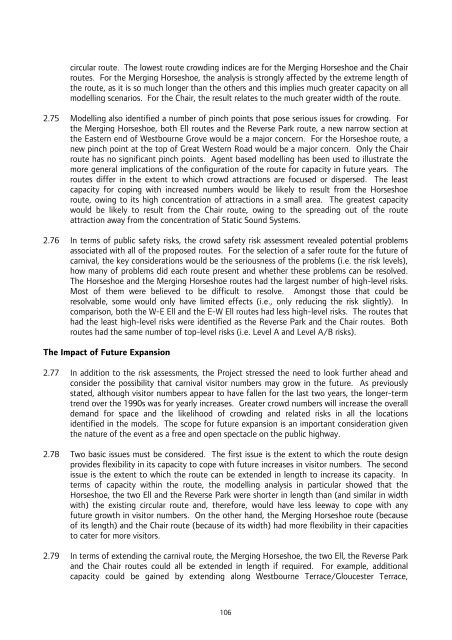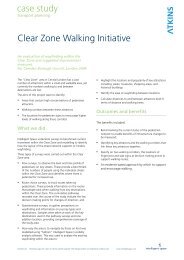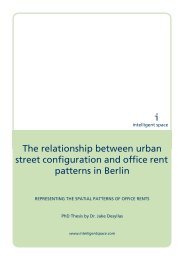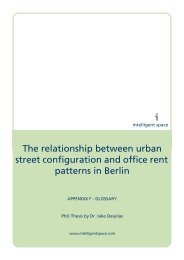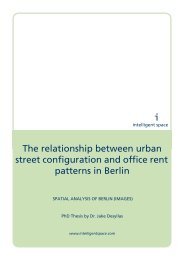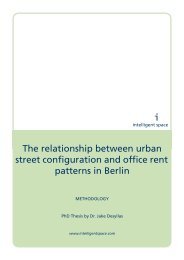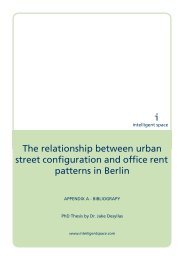Notting Hill Carnival Strategic Review - Intelligent Space
Notting Hill Carnival Strategic Review - Intelligent Space
Notting Hill Carnival Strategic Review - Intelligent Space
You also want an ePaper? Increase the reach of your titles
YUMPU automatically turns print PDFs into web optimized ePapers that Google loves.
circular route. The lowest route crowding indices are for the Merging Horseshoe and the Chair<br />
routes. For the Merging Horseshoe, the analysis is strongly affected by the extreme length of<br />
the route, as it is so much longer than the others and this implies much greater capacity on all<br />
modelling scenarios. For the Chair, the result relates to the much greater width of the route.<br />
2.75 Modelling also identified a number of pinch points that pose serious issues for crowding. For<br />
the Merging Horseshoe, both Ell routes and the Reverse Park route, a new narrow section at<br />
the Eastern end of Westbourne Grove would be a major concern. For the Horseshoe route, a<br />
new pinch point at the top of Great Western Road would be a major concern. Only the Chair<br />
route has no significant pinch points. Agent based modelling has been used to illustrate the<br />
more general implications of the configuration of the route for capacity in future years. The<br />
routes differ in the extent to which crowd attractions are focused or dispersed. The least<br />
capacity for coping with increased numbers would be likely to result from the Horseshoe<br />
route, owing to its high concentration of attractions in a small area. The greatest capacity<br />
would be likely to result from the Chair route, owing to the spreading out of the route<br />
attraction away from the concentration of Static Sound Systems.<br />
2.76 In terms of public safety risks, the crowd safety risk assessment revealed potential problems<br />
associated with all of the proposed routes. For the selection of a safer route for the future of<br />
carnival, the key considerations would be the seriousness of the problems (i.e. the risk levels),<br />
how many of problems did each route present and whether these problems can be resolved.<br />
The Horseshoe and the Merging Horseshoe routes had the largest number of high-level risks.<br />
Most of them were believed to be difficult to resolve. Amongst those that could be<br />
resolvable, some would only have limited effects (i.e., only reducing the risk slightly). In<br />
comparison, both the W-E Ell and the E-W Ell routes had less high-level risks. The routes that<br />
had the least high-level risks were identified as the Reverse Park and the Chair routes. Both<br />
routes had the same number of top-level risks (i.e. Level A and Level A/B risks).<br />
The Impact of Future Expansion<br />
2.77 In addition to the risk assessments, the Project stressed the need to look further ahead and<br />
consider the possibility that carnival visitor numbers may grow in the future. As previously<br />
stated, although visitor numbers appear to have fallen for the last two years, the longer-term<br />
trend over the 1990s was for yearly increases. Greater crowd numbers will increase the overall<br />
demand for space and the likelihood of crowding and related risks in all the locations<br />
identified in the models. The scope for future expansion is an important consideration given<br />
the nature of the event as a free and open spectacle on the public highway.<br />
2.78 Two basic issues must be considered. The first issue is the extent to which the route design<br />
provides flexibility in its capacity to cope with future increases in visitor numbers. The second<br />
issue is the extent to which the route can be extended in length to increase its capacity. In<br />
terms of capacity within the route, the modelling analysis in particular showed that the<br />
Horseshoe, the two Ell and the Reverse Park were shorter in length than (and similar in width<br />
with) the existing circular route and, therefore, would have less leeway to cope with any<br />
future growth in visitor numbers. On the other hand, the Merging Horseshoe route (because<br />
of its length) and the Chair route (because of its width) had more flexibility in their capacities<br />
to cater for more visitors.<br />
2.79 In terms of extending the carnival route, the Merging Horseshoe, the two Ell, the Reverse Park<br />
and the Chair routes could all be extended in length if required. For example, additional<br />
capacity could be gained by extending along Westbourne Terrace/Gloucester Terrace,<br />
106


